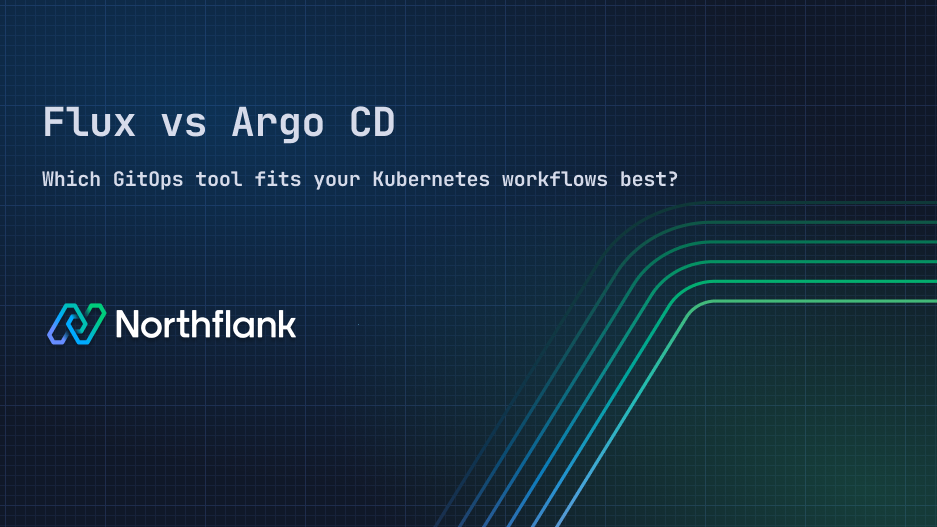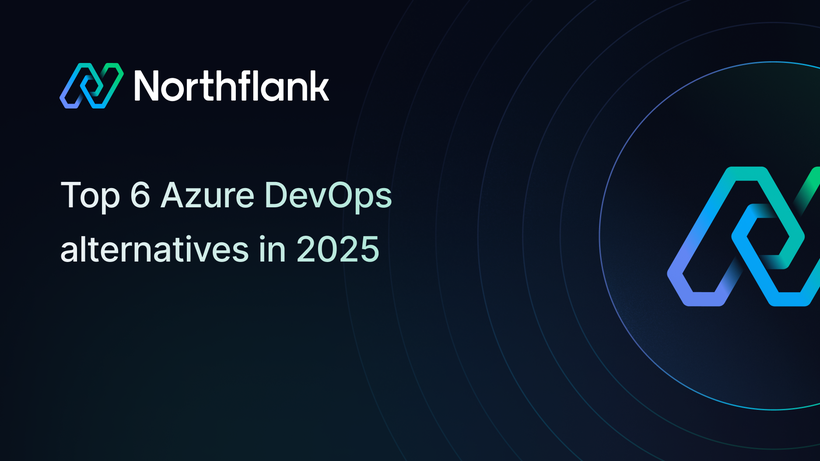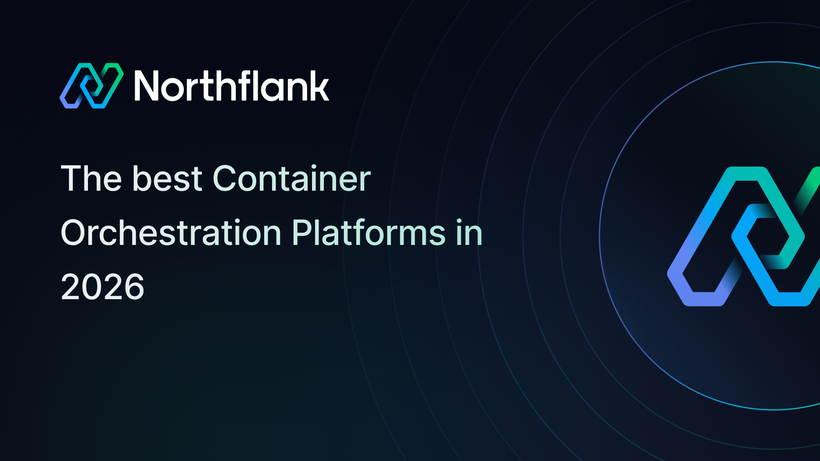

Flux vs Argo CD: Which GitOps tool fits your Kubernetes workflows best?
Have you noticed that recently, there have been many arguments around GitOps tools, especially Flux vs. Argo CD?
You’ll see most of these conversations all over Reddit, with people comparing Flux vs. Argo CD, not just because they’re both open source and CNCF-backed, but also because they take different approaches to solving similar problems.
If you're running workloads on Kubernetes and looking for a GitOps solution, you've likely come across both tools.
In this guide, we’ll explain how each one works, how it’s structured, and what that means for your deployments. You’ll also see how they compare in areas like observability, access control, and extensibility, with technical details to help you choose the best tool for your setup.
If you're building internal platforms, managing clusters at scale, or standardizing how applications get deployed, this walkthrough is for you.
If you’re already familiar with both tools and just want a quick side-by-side comparison, look at a breakdown of their key differences:
| Feature | Flux CD | Argo CD |
|---|---|---|
| Deployment model | Pull-based GitOps using Kubernetes controllers | Pull-based GitOps with optional manual sync and web UI |
| UI | No native UI (uses CLI + Grafana dashboards) | Full-featured web UI with visual status and controls |
| Observability | Exposes metrics via Prometheus, relies on external dashboards | Built-in status views, diffs, pod logs, and health status |
| Multi-tenancy | Based on Kubernetes namespaces and standard RBAC | Built-in AppProject abstraction for multitenancy |
| Access control | Uses native Kubernetes RBAC | Custom RBAC system configured via UI or config files |
| Helm support | Native Helm controller, supports all Helm features | Uses Helm via plugins or built-in Helm rendering |
| Custom resources | Everything is declarative with CRDs (Kustomize, Helm, etc.) | Applications managed via Argo CD Application CRD |
| Extensibility | Extend via additional controllers | Extend via config management plugins |
| Secrets support | Native support for SOPS | External tools via plugins (e.g., helm-secrets) |
| Multi-cluster support | Install one Flux per cluster | Single UI to manage multiple clusters centrally |
| Community & governance | CNCF graduated project, led by Weaveworks | CNCF incubating project, led by Intuit |
| Git provider support | GitHub, GitLab, Bitbucket, Azure Repos | GitHub, GitLab, Bitbucket, Azure Repos |
Flux CD is a GitOps controller built natively for Kubernetes. It keeps your cluster in sync with what's defined in your source of truth, usually a Git repository. Compared to CI/CD tools that trigger one-time deploys, Flux continuously reconciles state. If someone makes a manual change in the cluster, Flux detects the mismatch and reverts it. It doesn’t just deploy; it enforces consistency.

Behind the scenes, Flux runs a set of Kubernetes controllers that watch your source repositories, apply updates with tools like Kustomize and Helm, and handle things like image automation and notifications. You define everything as CRDs (Custom Resource Definitions), Git repositories, Helm charts, alerting rules, and Flux continuously ensures that your cluster reflects those resources.
You can see this play out in a Reddit post from r/devops where a user explains their real-world pipeline. They describe how Flux CD watches an ECR (Amazon Elastic Container Registry) repo for new images, detects changes, and triggers rolling updates (no manual kubectl needed).
“CD - Fluxcd operator running in k8s detects a new image in my ECR repo and updates the k8s manifest in my repo. This initiates a rolling update to my deployment.”
If you have similar needs, see this guide from Flux documentation on configuring image automation authentication.
You’ll often see Flux recommended by teams who are already deep into Kubernetes and prefer infrastructure that’s built from primitives. If your team already thinks in CRDs (Custom Resource Definitions) and reconciliation loops, Flux will feel like home.
It also fits well in scenarios where you want GitOps as a building block, not an opinionated full-stack experience. If you’re creating your own internal platform or need full control over how GitOps is integrated into your pipelines, Flux gives you that flexibility.
Here's a Reddit user explaining why Flux works well for them:
“The most useful features I found were the dependsOn and wait parameters that help me better manage dependencies...” ~ r/kubernetes

That’s the kind of low-level control Flux gives you; you can build very specific deployment flows without needing external plugins or UI workarounds.
Flux doesn’t ship with a built-in dashboard. That’s intentional; it follows the Unix philosophy of doing one thing well and leaving visualizations to tools like Grafana, Prometheus, or external dashboards. If your team relies heavily on UI for troubleshooting or monitoring, this may require some adjustment.
You’ll also find that onboarding can take a bit longer if your team isn’t already used to Kubernetes-native workflows. Everything is declarative, but it assumes you know your way around CRDs and controllers.
This Reddit post captures that initial friction clearly:
“What is the issue with just using a CI/CD tool such as GitHub Actions? From what I understand, they are mainly for k8s... can I not just use GitHub Actions for this?”

That question comes up often, and it shows why understanding how GitOps fits into modern cluster management is important before choosing a tool like Flux.
Argo CD is a declarative GitOps tool that syncs Kubernetes clusters with what’s defined in Git. Like Flux, it constantly watches for differences between your live cluster and your Git repository. When there’s a difference, Argo CD applies the changes automatically. The idea is that Git holds the source of truth, and Argo CD handles keeping everything aligned.

What sets Argo CD apart is its web UI. You get a real-time view of your deployments, things like:
- Which apps are out of sync
- What’s currently being deployed
- Where something is stuck
It also lets you dig into pod logs, run diffs on YAML, and even exec into containers if needed. It’s a practical tool for getting visual feedback on cluster state without leaving the browser.
This is one reason you’ll see Argo CD brought up more often in Reddit threads like this, asking which GitOps tool teams reach for the most.
“Although I personally prefer Flux over Argo CD, I got the impression that more people are using Argo CD...”

Argo CD’s user-friendly experience and multi-cluster management capabilities make it a go-to for teams that need visibility and control across multiple environments.
Argo CD makes GitOps feel more accessible. You don’t need to think in controllers or CRDs from day one. Most teams start with the web UI, and from there, they go deeper into how Argo CD fits into the rest of their tooling. It’s especially helpful when you want to give developers or app owners visibility into deployments without giving them direct Kubernetes access.
For platform teams managing several apps across staging and production clusters, Argo CD gives you one place to see it all. It’s also easier to standardize on policies when everyone is working through the same interface.
This Reddit post sums up a common reason:
“Besides what seems like the mainly-CLI focus of Flux vs. Argo, I can’t really find much to differentiate them in terms of capabilities...”

If you go through the comments on that post, you'll see that for many teams, it's less about core features and more about how they prefer to work. Some want a clean web UI with visual status and controls. Others prefer CLI-driven workflows and building with primitives.
Even though Argo CD and Flux both solve the same core problem, Argo CD’s focus on usability often tips the balance for teams that don’t want to build around lower-level abstractions.
The UI makes it easy to work with Argo CD, but that can come with trade-offs. For example, the access control model is separate from Kubernetes RBAC, and managing it at scale can get tedious. It’s also common to run into edge cases with Helm hooks or drift when charts are rendered differently than expected.
Here’s a thread on r/kubernetes where someone compares both tools in terms of configuration and flexibility:
“Those who have had to use them in real world PoCs or in production, what did you love or hate?”
If you read through the comments, you'll see a pattern: many teams say Argo CD works well out of the box, especially for getting started quickly. But when it comes to customizing workflows or plugging into more complex pipelines, the visual-first approach can feel limiting.
Also, if you’re self-hosting Argo CD, you’ll also need to manage the Kubernetes cluster it runs on. That includes the nodes, networking, and security updates. Compared to platforms where GitOps behavior is baked in, this setup can slow down time to value, especially for teams that just want to get deployments going without managing the GitOps engine itself.
Once you understand how each tool works on its own, the main decision comes down to how they fit into your workflow. You’re not just choosing based on features, you’re choosing:
- How much control you want
- How you manage clusters
- How much you want to build around GitOps.
Let’s see how Flux CD and Argo CD compare across key areas.
Flux CD uses native Kubernetes controllers to apply changes. Everything is defined as a CRD and handled through reconciliation loops. You push to Git, and the controllers pull and apply changes based on your setup. That means no need for templating engines or external plugins, just CRDs working the way Kubernetes intended.
Argo CD handles things a bit differently. It renders your manifests first, usually through Helm, Kustomize, or plain YAML, and then applies them with its GitOps Engine. That gives you visibility into diffs before things are applied, but also introduces room for drift if Helm charts don’t render the same way every time.
If you're using a lot of Helm charts with complex hooks or dynamic behavior, Flux might feel more stable. Argo CD’s model gives you more insight into what’s happening, but it might require extra configuration to avoid unexpected behavior.
This is one of the biggest differences. Argo CD ships with a full-featured UI. You can browse all your apps, see their live status, compare against Git, and take actions like syncing or rolling back, all from the browser.
Flux CD doesn’t come with a UI. You interact through the CLI or integrate it into other dashboards (e.g., with Grafana or Weaveworks' Web UI). If you prefer a command-line-first experience or want to plug it into your own observability stack, Flux gives you the space to do that.
Flux CD uses standard Kubernetes RBAC, which makes it easy to apply the same access model across all workloads, for Flux controllers or other workloads.
Argo CD uses its own internal RBAC system. You configure access through roles and permissions defined in the Argo CD config, separate from Kubernetes. This works well when all team members go through the UI, but it adds complexity if you need to manage access outside that context.
Both tools are CNCF projects, but they have slightly different paths. Argo CD has wider adoption, more GitHub stars, and a bigger ecosystem of community plugins and integrations. You’ll find more tutorials, YouTube videos, and templates.

Flux CD has fewer GitHub stars, but while its community is smaller, it has a very active group of maintainers and a growing list of adopters in production.

The focus is more on GitOps as a concept, with technical depth that appeals to teams already used to writing controllers or working with Kustomize.
Flux gives you building blocks. You can use sources like Git, Helm repos, OCI images, and S3 buckets as inputs, then define how to apply them with Kustomize controllers or Helm controllers.
 Kustomize controllers (Source: Flux documentation)
Kustomize controllers (Source: Flux documentation)
It’s very composable, and there’s built-in support for secrets management with SOPS.
 Helm controllers (Source: Flux documentation)
Helm controllers (Source: Flux documentation)
Argo CD supports plugins, and you can write your own config management plugins to work with tools like Helm Secrets. You can also extend the Argo CD UI and workflows, but it’s not as composable out of the box. It tends to work better when you follow its opinionated model rather than trying to bend it to your own.
Once you understand how each tool is built and how it behaves in production, the next question is: which one should you use for your team?
There’s no one-size-fits-all answer. The choice often comes down to how much abstraction you want and how your team prefers to work with Kubernetes.
Use Flux CD if:
- You want to keep everything in Git and use native Kubernetes patterns.
- Your team is already familiar with CRDs, reconciliation loops, and declarative infrastructure.
- You’re building an internal platform or pipeline that uses GitOps as a foundation, not an end-to-end UI.
- You want fine-grained control over the deployment flow, especially around ordering and dependencies.
Teams that go with Flux often value minimalism and transparency. You’re working with plain Kubernetes objects, so you can inspect, modify, and extend the system without relying on additional tools or custom dashboards.
This Reddit thread captures that mindset well:
“The most useful features I found were the dependsOn and wait parameters that help me better manage dependencies...” ~ r/kubernetes
If you’re working on infrastructure that requires high customization and you’re comfortable stitching things together, Flux gives you the primitives to build exactly what you need.
Use Argo CD if:
- You want a visual interface to manage deployments, view app status, and control syncs or rollbacks.
- Your developers need visibility without full access to the Kubernetes cluster.
- You’re managing multiple clusters from a central location and want to standardize how GitOps is applied across them.
- You prefer opinionated workflows that reduce setup time and abstract away some of the underlying complexity.
Argo CD is especially useful when you want teams to manage apps without touching kubectl. The UI helps onboard new users, and the built-in RBAC system gives you a way to control who can see and modify what.
You can also set up Argo CD to sync automatically or require manual approvals, making it a good fit for staged environments like dev → staging → prod.
This comment from r/devops reflects that:
“Argo CD just makes it easier to show devs what’s happening in the cluster. They can roll back or trigger syncs without needing to understand Helm or kubectl.”
Choosing between Flux and Argo CD often comes down to how much control you want versus how much setup you're willing to manage. Some teams prefer stitching together tools and building workflows from primitives.
Others want visual feedback and a clear UI. But there's a third group, teams that want GitOps behavior without maintaining the GitOps engine themselves.
That’s where Northflank fits in. It’s not a GitOps operator like Flux or Argo CD, but it brings Git-based deployment flows into a full platform.

You connect your repo, define your services in Git, and Northflank handles your builds, deployments, and syncing. It applies the principles of GitOps without asking you to manage CRDs, build custom dashboards, or run extra controllers.
That kind of experience also avoids some of the overhead teams deal with when managing GitOps themselves. Flux already supports more than just Helm, it works with Kustomize, plain YAML, and more. But if you’re using Helm, you’re still writing and maintaining templated YAML. For many teams, that’s where GitOps starts to feel too hands-on. Northflank removes that layer entirely. You define your services and configs in simple Git structure, and the platform handles the deploys. No Helm, no YAML templating, no mismatches between what’s in Git and what’s running.
Note: If you’re wondering how this kind of platform approach compares to managing your own GitOps tooling, this breakdown of build vs buy for platform teams goes deeper into the trade-offs.
If you’ve been comparing Flux CD and Argo CD, chances are you’ve had some of these questions. Here’s a quick rundown of what people usually ask, and what you should know before picking a tool.
It depends on what you need. Flux is better for low-level control and Kubernetes-native workflows. Argo CD works well if you want a UI and app-focused experience.
They're GitOps tools that sync your Kubernetes cluster with what's defined in Git. Flux is controller-based; Argo CD runs as a separate service with a UI.
Flux integrates deeply into Kubernetes and is modular. Argo CD is centralized and comes with built-in app management features.
It can be heavy at scale, and the custom RBAC config isn’t always intuitive. You’ll also rely on its central UI service being up and stable.
Pros: Native to Kubernetes, highly flexible, ideal for infra.
Cons: No UI out of the box, steeper learning curve for beginners.
Tools like Northflank offer GitOps with built-in logs, CI, and infra control. It depends on how much abstraction you want.
Argo Rollouts handles canaries and blue-green deploys. Flux doesn't include rollout strategies by default; you’ll need to configure that yourself.
Yes. Some teams use Flux for infra and Argo CD for app teams. It’s common in large orgs that split platform and app responsibilities.
If you’re optimizing for developer experience and want a centralized UI to manage app deployments across clusters, Argo CD is a reliable choice. It gives you visibility and controls that dev teams appreciate out of the box.
If you’re building internal platforms or managing infrastructure as code at scale, Flux gives you more control. It fits right into Kubernetes with native CRDs and lets you compose complex setups without extra tooling.
You don’t need to pick one forever. Some teams even use both: Flux for infra, Argo CD for apps. And if you’re looking for a third path, something that wraps GitOps into a developer-friendly PaaS, you’ll find options like Northflank helpful.
Want to try a platform that simplifies GitOps without limiting your control? Sign up for Northflank and see how it works in practice.


